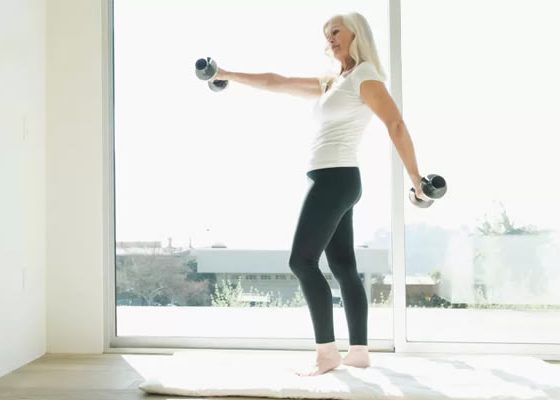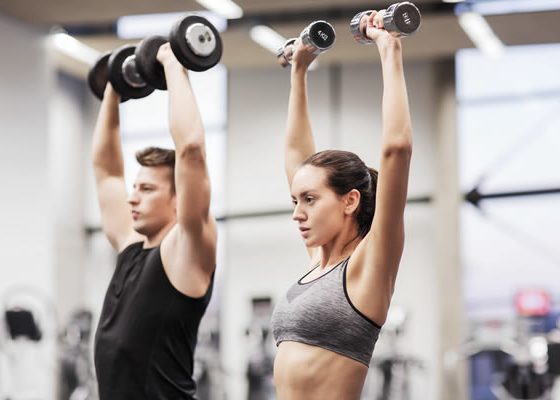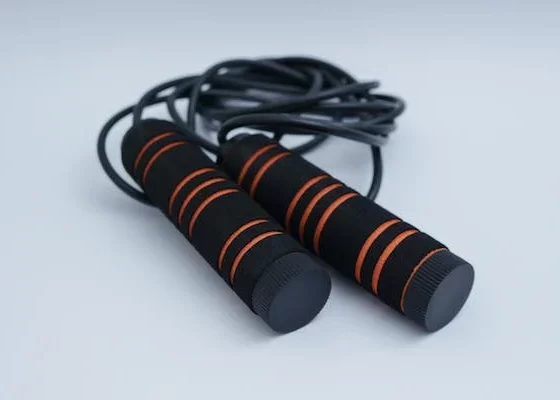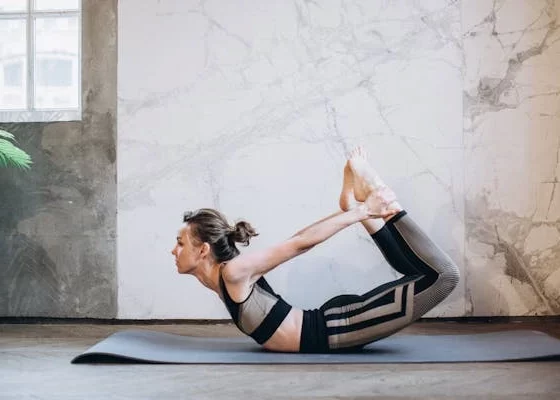Most yoga styles tone and lengthen muscles, but doing weight training to help with yoga postures is a good idea if you’re ready to move on to a more advanced practice.
Getting Started
If you decide to try weight training to help with yoga postures, there are a number of things to consider.
- Develop an all-body workout. Create a weightlifting routine for the entire body, not just your arms or legs. As yoga teaches us, everything in our body is connected. For example, having a strong torso will help with balancing pastures just as much as having strong legs will. By developing a universal weight program, you’ll gain more benefits. However, you’ll focus on different muscle groups on alternate days.
- Allow for rest and recovery. Make sure to modify your yoga practice to allow for muscle recovery after weight training. When you lift weights, you cause microscopic tears in the muscle. You gain muscle when the body builds tissue to repair that damage. Your muscles usually need 36-48 hours of recovery. Plan to have more of a restorative yoga session the day of or after lifting weights. On the second day after, you can do a more vigorous routine.
- Don’t use weights during your yoga session. This is hot trend, but it’s not the best option. Form tends to be compromised, which could lead to injury. Also, it’s important to remember the whole practice of asana, not simply the physicality of it.
Ideas for Weight Training to Help with Yoga Postures
When weight training, some experts suggest using high weight with fewer repetitions in order to build strength. Then, use yoga to tone your muscles and increase your endurance. A good combination is iron weights, kettlebells, and moves that use your body as resistance.
Strengthening the Core
You know how many postures require a firm center of power, such as Plank Pose, Side Plank, Tree Pose, Eagle Pose, and Bridge Pose. Here are some suggestions to help improve your core.
- Weights and kettlebells:
-
- Russian Twists – Sit down and bend your knees to 90 degrees. Using a 10-15 lb. dumbbell, swing the weight from left to right, moving your shoulders but not your hips. Keep your arms low at your sides, elbows tucked. Do this for 30-45 seconds, rest 15 seconds, and repeat.
- Kettlebell Swing – Spread your legs a little more than hip-distance apart. Using an 8 lb. kettlebell (or kilogram equivalent), hold the kettlebell in your right hand lightly as you swing it upward. Squat and bring the kettlebell between your legs. Repeat this motion, driving from your legs and using your core for stability. Do this for 15-30 seconds, then switch to the left hand for another 15-30 seconds. Rest for 30 seconds and repeat.
- Body resistance:
-
- Plank Pose – The best way to hold Plank longer is to practice it more often! If you’re just starting out, hold Plank for 15 seconds, then drop to your knees and hold for 30 seconds. Rest in Child’s Pose for 30 seconds and repeat the sequence.
- Dolphin Pose – This uses the same principle as Plank, only you’re supporting yourself on your forearms and not the entire length of the arm. Follow the same sequence as above.
Building Leg Muscle
With greater leg strength, you’ll see better performance in poses such as the Warrior Series, Lord of the Dance, Eagle Pose, Tree Pose, and Wide-Legged Forward Bend.
- Weights and kettlebells:
-
- Kettlebell Side-Step – Spread your legs a little wider than hip-distance apart. Using 8 lb. kettlebell (or kilogram equivalent) in your right hand, start the Kettlebell Swing. On the next upswing, close the legs together, then quickly squat again as you move to the left and bring the kettlebell between your knees. Upswing, legs closed, left leg extends sideways into the squat, kettlebell swings between your knees. Repeat as far left as you can go, then switch the kettlebell to the left hand as the right leg opens and extends to take you back to start. Repeat for 30-60 seconds, rest for 30 seconds, and repeat both sides.
- Dumbbell Lunges – Hold 5-15 lb. weights at your sides. Put the front of your right foot on the edge of a chair or bench, and drop your left leg into a lunge. Do this for 12-15 repetitions, switch legs and repeat. Rest for 30 seconds, and repeat both sides.
- Body resistance:
-
- Low Lunge – This yoga move will build leg strength. Starting in Plank Pose, extend your right leg forward, taking care that the knee doesn’t come over the toe. Extend the left leg, foot flexed. Hold for 30 seconds. Return to Plank, then extend the left leg into Lunge, right leg back. Again, hold for 30 seconds. Rest in Child’s Pose, and repeat the sequence.
Improving the Shoulders, Back, and Arms
Firefly Pose, Crane Pose, and Headstand/Shoulderstand are just a few postures that rely on a powerful upper body.
- Weights and kettlebells:
-
- One-Arm Dumbbell Rows – These can be done with either a dumbbell or kettlebell. Use both a higher weight and then a slightly less weight. Extend your left leg into a slight lunge while your right leg stretches back. Pick up the heavier weight in your right hand and lean forward slightly, hinging at the waist. Draw the weight back, elbow close to the side, and “row” with that arm for 20-30 seconds. Then, pick up the lighter weight and continue for another 20-30 seconds. Rest for 30 seconds, and repeat on the left side.
- Behind-the Neck Pulley Rows – Pick a weight, then grasp the bar in both hands, lowering it behind your head as you sit on the bench. Make sure your arms are outstretched, but not hyperextended. Pull the bar down just below your ears, and let the weight raise your arms back up. Do three sets of 12-15 repetitions.
- Body resistance:
-
- Pushups – This classic move never goes out of style. Do 15-30 pushups either on your knees or legs extended. Rest for 30 seconds, then repeat.
- Tricep Lift – Using a sturdy chair or ottoman, place your palms behind you on the surface edge and dip your body down, then push into the surface to rise back up. Do 15-30 repetitions, rest 30 seconds, then repeat.
Keep a Chart
To make sure you know how to alternate your weight training with your yoga practice, keep a chart of what muscles groups you worked on which day. That way, you’ll restore the muscles most recently conditioned first.



